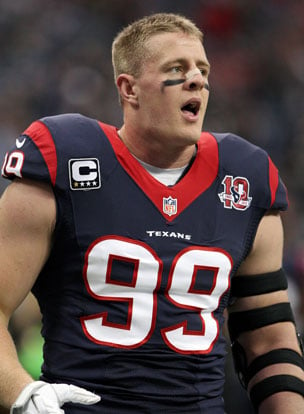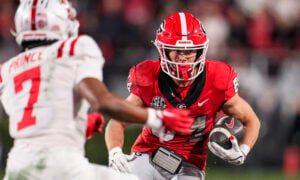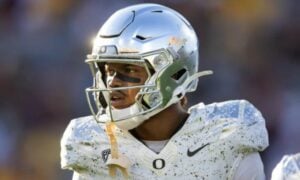IDP Scheme Changes, Part One
One of the most important IDP actions to monitor throughout the off season is scheme changes. They can have a huge impact on the IDP landscape, present opportunities for value on the waiver wire, or destroy IDP stud value.
For example, when the Houston Texans switched from a 3-4 base to a 4-3 base scheme in 2011 it resulted in an IDP position switch for Mario Williams from a defensive end to an outside linebacker. As many of us know, that destroyed Williams’ IDP value in tackle-heavy leagues as, generally, outside linebackers are tough to depend on in that format.
On the flipside, a switch from a 3-4 base scheme may find an outside linebacker swapping to a defensive end – that could result in a big spike in a player’s IDP value if a guy moves from outside linebacker to defensive end given the handful of studs at latter.
There are a number of IDP impacting changes that have happened thus far in 2014. The annual scheme changes is another example supporting that taking IDP studs early in a rookie startup may not be the best strategy. Philosophy changes have a significant and immediate impact on the defensive side of the ball, much more than on the offensive side.
Here is an early take on how things are falling into place:
Houston Texans
 With the hiring of Romeo Crennel as the Texans’s defensive coordinator, there’s an underlying issue that’s festering which should raise some concern for JJ Watt owners. Former defensive coordinator Wade Phillips ran a one-gap 3-4 defense over the past few years. He also gave Watt a ton of freedom to take advantage of his athletic ability – that led to dominant production.
With the hiring of Romeo Crennel as the Texans’s defensive coordinator, there’s an underlying issue that’s festering which should raise some concern for JJ Watt owners. Former defensive coordinator Wade Phillips ran a one-gap 3-4 defense over the past few years. He also gave Watt a ton of freedom to take advantage of his athletic ability – that led to dominant production.
Crennel, on the other hand, has historically run a two-gap 3-4 defense. If Crennel applies this philosophy to the Texans, it’d be a huge hit to Watt’s value. The switch would limit Watt’s production and push him towards a defensive end whose primary purpose is to occupy bodies. In essence, this would move Watt from an end whose job is to get to, pressure and sack the quarterback to an end whose purpose is to clog bodies and create space for his linebackers. It’d be wasting Watt’s talent.
To take advantage of Watt’s abilities, there’s also the possibility that Crennel decides to use Watt in an elephant role like he used Willie McGinest of the Patriots a number of years ago. If that happens, we could be looking at a position designation switch to outside linebacker. That, also, is horrible for Watt owners.
The bottom line is that Watt owners need to be on top of this throughout the off-season, but it’s not trending positively and we are potentially looking at a reduction in value here.
There aren’t any other major impacts of this hire for Houston.
Buffalo Bills
Yet another season with a potential scheme change for the Bills. Last year, Mike Pettine implemented a 3-4 base defense and now with Jim Schwartz in the picture, a switch to a 4-3 base is likely. His linebacker coach recently confirmed that. In his introductory news conference, Schwartz was pressed if it’ll be a wide-9 base defense, which he’s often associated with. He was emphatic that wide-9 is not his base defense. Regardless, we’re likely to see wide-9 package applied; it just won’t be the dominating factor.
Here’s how the switch to a 4-3 base defense may impact some key Buffalo players:
Mario Williams, DE
Pettine’s exit and Schwartz’s entrance cements Williams with a defense end IDP designation. Given that Pettine ran a multiple front favoring a 3-4, there was some concern last year that 2014 would bring a positional change to linebacker for Williams – that’s not happening now. While Pettine got the most out of Williams and played his strengths, Williams is a natural 4-3 defensive end and, as a result, this shift works in his favor. Expect the 4-3 base to pump up Williams’s production as compared to 2013.
Kiko Alonso, MLB
Alonso is fantastic at attacking the line of scrimmage. Expect that to continue as he assumes the middle linebacker spot in 2014. There’s enough talent on the defensive line among Mario Williams, Marcell Dareus and Kevin Williams to keep Alonso free and making plays. This is a lateral value move in value with this scheme shift, if not a slight increase.
Marcell Dareus / Kyle Williams, DT
As we know, a 4-3 defensive tackle holds more IDP value than a 3-4 nose tackle. Dareus is coming off his best season as a pro and looks to be a top option in defensive tackle required leagues again in 2014 with the shift back to a 4-3 tackle.
Jerry Hughes, DE
Hughes is likely headed back to a defensive end designation in 2014 with this scheme change. The defense end designation will increase his value immediately, especially given his nine plus sacks in 2013. Expect to see Hughes on the field as a pass rushing specialist when the wide-9 is applied. He’s an undersized defensive end who could potentially thrive in Schwartz’s system and possesses some upside in deeper leagues as a result.
Tennessee Titans
New head coach Ken Whisenhunt brought in Ray Horton to run his defense. As we saw with these two in Arizona, their tendency is a 3-4 base. While Horton has been adamant that his defense can’t be categorized and he just puts his players in the position to make plays, this defense will be a hybrid 3-4. He successfully implemented that in Cleveland this past year and improved the IDP stock of players like TJ Ward. Expect an increase in turnovers and a general uptick in linebacker production, which is a good thing for all IDP owners, but particularly big-play leagues.
Overall, the Titans’ inside starting linebacker spots will be a position to keep a close eye on throughout the off season. Here are the most impacted players:
Akeem Ayers, ILB
Ayers may see the largest increase in value. Assuming a linebacker isn’t added via the draft or free agency, Ayers will have a legitimate shot to start inside. Moving from a strongside linebacker spot in a 4-3 to an inside linebacker spot should greatly increase Ayers’ tackle opportunities.
Zach Brown, ILB
Think Daryl Washington and Lawrence Timmons. That’s exactly the role Brown is likely to play in Horton’s new defense. Horton loves speedy athletic linebackers who can cover sideline to sideline and run free behind the defensive line to make plays. Brown is set to move to the weak inside linebacker spot and should see an increase in production. Many question Brown’s consistency especially after struggling in his second year and losing snaps as the year progressed, but this scheme shift may work in Brown’s favor.
Colin McCarthy, ILB
Some believe this change may be a rebirth opportunity for McCarthy. That’s possible, but there’s a ton of competition inside on the roster already. Brown is a virtual lock for an insider starter spot, Ayers is likely to start alongside Brown, and Zaviar Gooden is a dark horse candidate in the competition for inside linebacker snaps – that leaves the disappointing and oft-injured McCarthy with the proverbial up-hill battle. He’s worth a shot if he comes cheaply, but don’t overpay or assume he’ll win out.
Zaviar Gooden, ILB
Like Ayers, Gooden will compete for the inside linebacker spot next to Brown. While the presumption is that Ayers will win that spot, don’t dismiss Gooden. He has tremendous speed (like Brown) and is solid in coverage. As mentioned, Horton loves speed, so either stash or keep an eye on Gooden until the inside spots are settled.
Derrick Morgan, OLB
It’s not clear exactly how Morgan will be used yet, but it’s likely he’ll stand up as an outside linebacker. Either way, his value takes a hit. His sack potential as a defensive end would drop and his IDP value as an outside linebacker will drop compared to others given the low tackle production at the position. If he bulks up and stays at defensive end, it’s difficult to see him succeeding given his size and pass rushing tendencies.
Kamerion Wimbley, OLB
In his two seasons with the Titans, Wimbley has been a huge disappointment. Assuming he’s not cut, this move should work in Wimbley’s favor as he’ll move to outside linebacker. With the position eligibility shift from defensive end to linebacker, unless you’re in a big-play league where 3-4 OLBs are worth something meaningful, Wimbley is really only worth monitoring. His ceiling is probably 40-45 solo tackles and 8-10 sacks.
Jurell Casey, DE
Given his size, Casey should stick at defensive end in Horton’s 3-4. Like the prior two defensive ends, this shift should negatively impact his IDP value. He’s still a worthy IDP target, though. Horton’s lineman (see Calais Campbell and Darnell Dockett) generally still produce sacks and Casey is big enough to be productive in run support. His value takes a hit, but he’s still a viable option.
Check back in tomorrow for the second installment where we’ll dig deeper into the changes in Dallas, Tampa Bay and Cleveland.


































































